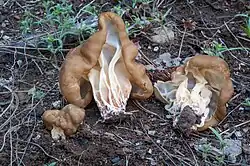Gyromitra californica
| Gyromitra californica | |
|---|---|

| |
| Scientific classification | |
| Kingdom: | Fungi |
| Division: | Ascomycota |
| Class: | Pezizomycetes |
| Order: | Pezizales |
| Family: | Discinaceae |
| Genus: | Gyromitra |
| Species: | G. californica
|
| Binomial name | |
| Gyromitra californica (W. Phillips) Raitv. (1965)
| |
| Synonyms[2] | |
| |
Gyromitra californica, commonly known as the umbrella false morel,[3] is a species of fungus in the family Discinaceae.[2] It was described as Helvella californica by W. Phillips in 1879, collected near Yét Atwam Creek, just south of McCloud, California.
The tannish cap is up to 12 centimetres (4+3⁄4 in) wide and the whitish stalk is up to 8 cm long and 5 cm thick.[3]
It is considered probably poisonous.[4] However, poisoning reports do not exist for G. californica and the toxin gyromitrin has not been detected in raw samples.[5]
References
- ^ NatureServe. "Gyromitra californica". NatureServe Explorer. Arlington, Virginia. Retrieved 26 May 2025.
- ^ a b "Gyromitra californica (W. Phillips) Raitv. (1965)". MycoBank. International Mycological Association. Retrieved 2019-06-18.
- ^ a b Arora, David (1986) [1979]. Mushrooms Demystified: A Comprehensive Guide to the Fleshy Fungi (2nd ed.). Berkeley, California: Ten Speed Press. p. 804. ISBN 978-0-89815-170-1.
- ^ Miller Jr., Orson K.; Miller, Hope H. (2006). North American Mushrooms: A Field Guide to Edible and Inedible Fungi. Guilford, CN: FalconGuides. p. 508. ISBN 978-0-7627-3109-1.
- ^ Dirks, Alden C.; Mohamed, Osama G.; Schultz, Pamela J.; Miller, Andrew N.; Tripathi, Ashootosh; James, Timothy Y. (2023-01-02). "Not all bad: Gyromitrin has a limited distribution in the false morels as determined by a new ultra high-performance liquid chromatography method". Mycologia. 115 (1): 1–15. doi:10.1080/00275514.2022.2146473. ISSN 0027-5514. PMID 36541902.
External links
| Gyromitra californica | |
|---|---|
| Smooth hymenium | |
| Hymenium attachment is not applicable | |
| Stipe is bare | |
| Ecology is saprotrophic | |
| Edibility is not recommended or poisonous | |
